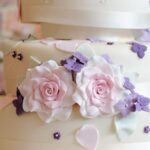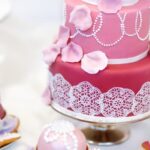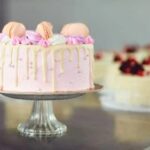What are the duties of a cake decorator? Cake decorators are skilled professionals who specialize in creating visually appealing and delicious cakes for various occasions. From birthdays to weddings, cake decorators play a crucial role in bringing the sweetness and beauty to any celebration. In this article, we will explore the various responsibilities and skills required to excel in the art of cake decorating.
Cake decorators are not just bakers; they are artists who use their creativity and expertise to transform plain cakes into stunning works of art. They are responsible for designing, planning, and executing visually striking decorations while ensuring that the taste is equally delightful. In addition to artistic talent, they also need to possess certain skills and qualifications to excel in this field.
In this article, we will delve into the essential skills and qualifications needed for cake decorating, the importance of proper cake preparation, different types of icing and fondant used in decorating, as well as the techniques and tools employed by cake decorators. Understanding these aspects is crucial for anyone aspiring to become a successful cake decorator. So let’s explore the exciting world of cake decoration and discover what it takes to excel in this creative and delectable profession.
Required Skills and Qualifications for Cake Decorating
A cake decorator is a professional skilled in the art of decorating cakes for various occasions, such as birthdays, weddings, and other celebrations. The duties of a cake decorator require creativity, precision, and attention to detail to create visually stunning and delicious works of art. To excel in this role, individuals must possess specific skills and qualifications that allow them to carry out their duties effectively.
Skills and Qualifications
To become a successful cake decorator, individuals must possess a combination of artistic talent, technical skill, and knowledge of baking techniques. Some of the required skills and qualifications for cake decorating include:
- Artistic Ability: A strong eye for design and color is essential for creating aesthetically pleasing cake decorations.
- Attention to Detail: Cake decorators must have a meticulous approach to ensure precise and flawless designs.
- Baking Knowledge: Understanding the science behind baking is crucial for creating cakes with the right texture and flavor.
- Creativity: The ability to think outside the box when designing unique and custom cake decorations.
- Time Management: Efficiently managing time to meet deadlines while maintaining high-quality standards.
In addition to these skills, formal training in baking and pastry arts from culinary schools or specialized programs can provide aspiring cake decorators with the necessary technical expertise. Many employers also look for candidates with experience working in commercial bakeries or pastry shops to demonstrate their practical knowledge in a professional setting.
Licensing and Certifications
Depending on location, certain jurisdictions may require cake decorators to obtain food safety certifications or licenses to ensure adherence to health regulations when handling food products. These credentials demonstrate that the individual has received proper training in sanitation practices and food handling procedures.
Understanding the Importance of Proper Cake Preparation
Proper cake preparation is crucial for a cake decorator as it serves as the foundation for the decorating process. The first step in this process involves baking a perfect cake that is level, moist, and has the right texture to hold up the decoration.
Understanding different types of cake batters and their baking times is essential to achieve this. Additionally, cake decorators must also have knowledge of various cake sizes and shapes in order to choose the best one for a specific design.
Another important aspect of proper cake preparation is leveling and layering the cakes. This ensures that the finished product not only looks professional but also tastes delicious. It’s imperative to evenly stack and frost each layer ensuring that they are stable before moving on to the decorating stage. Any irregularities in the base will affect the overall appearance and quality of the finished product.
Cake decorators should also be knowledgeable about various filling options such as fruit, mousse, or buttercream fillings depending on the customer’s preference or theme of an event. These preparations require attention to detail and precision because they serve as added flavor dimensions to complement the entire cake presentation.
| Aspect of Cake Preparation | Importance |
|---|---|
| Baking a perfect cake | Serves as foundation for decorating |
| Leveling and layering cakes | Ensures professional appearance and taste |
| Filling options | Adds flavor dimension to complement presentation |
Designing and Planning the Cake Decoration
Once the cake decorator understands the importance of proper cake preparation, it is time to move on to the design and planning phase. This is where the creativity of the cake decorator truly shines, as they brainstorm ideas and create a vision for the final product. Here are some key duties involved in designing and planning the cake decoration:
- Consulting with clients: One of the main duties of a cake decorator is to meet with clients to discuss their specific needs and preferences. This could include themes, color schemes, and any specific elements that the client wants to be incorporated into the design.
- Sketching and creating blueprints: Before diving into the decoration process, a cake decorator may need to sketch out different designs or create blueprints to visualize how the final product will look. This step helps ensure that both the client and decorator are aligned on expectations.
- Choosing appropriate decorations: Depending on the design chosen, a cake decorator must source and select suitable decorations such as fresh flowers, edible figurines, or customized toppers.
In addition to these duties, a cake decorator must also consider factors such as budget constraints, timeline for completion, and any special dietary restrictions or allergies that need to be accommodated. Overall, this phase requires meticulous attention to detail and effective communication skills in order to bring the client’s vision to life.
Finally, a crucial responsibility in this stage is developing a plan for executing the design. This includes mapping out each step of the decorating process, ensuring that all necessary tools and materials are available, and determining a schedule for completing each aspect of the decoration. Ultimately, successful designing and planning sets the foundation for a stunning finished product that meets or exceeds client expectations.
Techniques and Tools Used in Cake Decorating
Cake decorating involves a wide range of techniques and tools to create beautiful and visually appealing designs on cakes. These techniques can include piping, fondant work, sculpting, airbrushing, and more.
Piping is one of the most common techniques used in cake decoration, which involves using a pastry bag to apply frosting or icing onto the cake in various designs and patterns. Fondant work, on the other hand, uses a type of sugar paste that can be rolled out and draped over the cake to create a smooth and flawless finish.
In addition to these techniques, cake decorators also employ various tools to aid them in their craft. These tools may include different types of pastry bags and tips for piping, fondant smoothers for creating clean finishes, sculpting tools for shaping fondant or gum paste decorations, as well as airbrush kits for adding color gradients or intricate details to the cake. Understanding how to use these tools properly is crucial for achieving professional-looking results in cake decoration.
It’s important for cake decorators to stay updated on the latest trends and innovations in cake decorating techniques and tools. With new methods constantly being developed in the industry, staying informed about these advancements can help decorators improve their skills and offer clients unique and creative options for their special occasions.
| Techniques | Tools |
|---|---|
| Piping | Pastry bags and tips |
| Fondant work | Fondant smoothers |
| Sculpting | Sculpting tools |
| Airbrushing | Airbrush kits |
Understanding Different Types of Icing and Fondant
Types of Icing
One of the key duties of a cake decorator is to understand the different types of icing used in cake decorating. Buttercream icing is one of the most common types, known for its smooth and creamy texture. It’s easy to work with and can be easily colored and flavored.
Royal icing, on the other hand, is a hard-drying icing often used for intricate designs and decorations. Fondant is another popular choice, known for its smooth and polished finish. It can be rolled out and used to cover cakes or shaped into various decorative elements.
Working With Fondant
Cake decorators also need to have a good understanding of fondant, as it is widely used in professional cake decorating. They should know how to properly roll out the fondant to cover a cake without creating air bubbles or creases. Additionally, knowing how to shape fondant into 3D figures or intricate designs is crucial for creating visually appealing cakes.
Coloring Techniques
In addition to understanding different types of icing and fondant, cake decorators must also be skilled in coloring techniques. This includes knowing how to mix and blend colors to achieve custom shades, as well as using various tools such as airbrushes or paintbrushes for precision coloring. Mastering color techniques allows decorators to bring their creative visions to life on their cakes.
Overall, being knowledgeable about the different types of icing and fondant, as well as possessing the skills to work with them effectively, are important duties of a cake decorator. These skills are crucial in creating stunning and delicious works of edible art that leave a lasting impression on clients and guests alike.
Working With Edible Decorations and Coloring
Understanding the Role of Edible Decorations
One of the key duties of a cake decorator is the skillful use of edible decorations to enhance the appearance and appeal of a cake. This includes using various edible items such as fresh fruits, chocolate shavings, candy, and edible flowers to add color, texture, and visual interest to the cake.
Cake decorators must have a keen eye for creativity and design to effectively utilize these edible decorations in a way that complements the overall theme or concept of the cake.
Importance of Color Theory in Cake Decorating
Another crucial aspect of cake decoration is understanding and applying color theory. Cake decorators need to have an understanding of how different colors work together harmoniously to create visually appealing designs. They must be able to mix and match colors effectively when using food coloring for icing and decorative elements. A good sense of color coordination can elevate a cake from ordinary to extraordinary.
Utilizing Coloring Techniques
Cake decorators utilize various coloring techniques such as airbrushing, painting with edible food colors, marbling, and piping to create intricate designs on cakes. These techniques require precision, control, and artistic flair. Whether it’s creating ombre effects or mastering intricate patterns, the ability to use coloring techniques is an essential duty for cake decorators.
In summary, In conclusion *)___ (Do not include this part).
Importance of Attention to Detail in Cake Decoration
Cake decoration is not just about making a cake look visually appealing; it’s also about attention to detail. Attention to detail is a crucial aspect of cake decoration, as it can make or break the overall appearance of the cake. It involves focusing on the small intricacies that go into creating a beautifully decorated cake, ensuring that every aspect of the design is carefully executed.
One of the main duties of a cake decorator is to pay close attention to detail when creating intricate designs and patterns on the cake. This includes ensuring that lines are straight, colors are blended seamlessly, and intricate designs are carefully piped or sculpted. Every little detail, from the positioning of decorations to the smoothness of the icing, must be meticulously attended to in order to achieve a professionally finished product.
Another important aspect of attention to detail in cake decoration is ensuring that the final product matches the client’s specific requirements and expectations. This may involve carefully following a design brief or taking note of any special requests or preferences made by the client.
The ability to carefully listen and interpret these details is essential in delivering a personalized and tailored cake decorating service. Ultimately, attention to detail not only enhances the visual appeal of the cake but also ensures customer satisfaction by delivering exactly what was requested.
Time Management and Organization in Cake Decorating
When it comes to cake decorating, time management and organization are crucial skills that every cake decorator must possess. With multiple orders, tight deadlines, and various tasks to juggle, it is important for a cake decorator to effectively manage their time and stay organized in order to deliver high-quality cakes to their clients.
One of the key duties of a cake decorator is to efficiently plan and schedule their workload. This includes prioritizing orders based on their due dates, understanding the time required for each decoration task, and allocating sufficient time for necessary preparations. Additionally, effective time management also involves being able to work efficiently without compromising the quality of the final product.
In addition to time management, organization plays a vital role in ensuring that the cake decorating process runs smoothly. This includes maintaining a well-organized workspace, keeping all tools and supplies easily accessible, and having a systematic approach to completing decoration tasks. By staying organized, a cake decorator can avoid unnecessary delays and ensure that they have everything they need at hand when working on different cake designs.
Overall, the duties of a cake decorator include not only creating beautiful and intricate designs but also effectively managing their time and staying organized throughout the entire decoration process. These skills allow decorators to meet client expectations, deliver stunning cakes on schedule, and ultimately thrive in the competitive world of cake decorating.
Conclusion
In conclusion, the art of cake decoration is a delicate and intricate process that requires a combination of artistic skills, technical knowledge, and attention to detail. A skilled cake decorator must possess a thorough understanding of various cake decorating techniques, tools, and ingredients to create visually stunning and delicious masterpieces. From designing and planning the decoration to working with edible decorations and coloring, every step in the process plays a crucial role in creating a beautiful and appetizing cake.
The duties of a cake decorator go beyond just making a cake look good; it also involves ensuring that the cake tastes as good as it looks. This requires an understanding of different types of icing and fondant, as well as the importance of proper cake preparation to achieve the desired results. Furthermore, attention to detail is essential in order to bring intricate designs to life and provide customers with cakes that exceed their expectations.
Ultimately, time management and organization are key skills for a successful cake decorator. Balancing multiple orders, meeting deadlines, and maintaining quality standards all require careful planning and efficient work processes. The artful execution of these duties makes a cake decorator an integral part of any bakery or confectionary business, adding value through their creativity and expertise in bringing joy to people’s celebrations through beautifully decorated cakes.

Welcome to my blog about home and family. This blog is a place where I will share my thoughts, ideas, and experiences related to these important topics. I am a stay-at-home mom with two young children. I hope you enjoy reading it! and may find some helpful tips and ideas that will make your home and family life even better!





